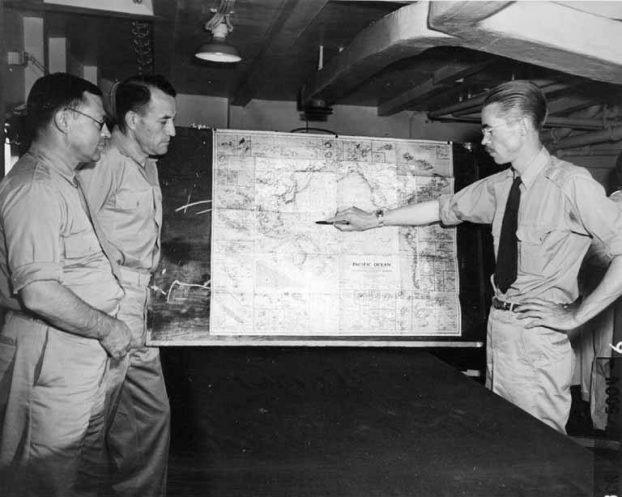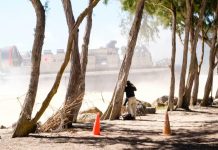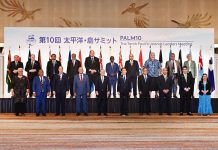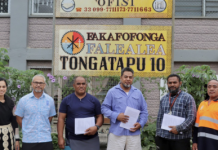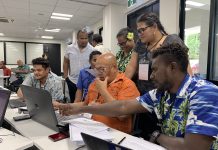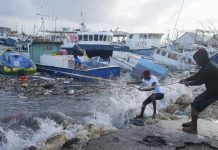By Camilla Pohle
Members of a U.S Senate hearing on 14 March said that Washington’s relationships with Pacific Island countries are based on respect. If this is true, the United States must compensate and apologise to Marshallese victims of U.S radiation experiments that began in the 1950s.
The Marshall Islands is a crucial U.S partner, with a diaspora in this country, but the relationship is marred by this longstanding injustice.
The United States administered the Marshall Islands as a trust territory from 1947 to its independence in 1986, and was obligated to protect its welfare. Yet under Project 4.1, a secret U.S medical program implemented in 1954, American scientists violated the human rights of the Marshallese people, studying the effects of radiation on them without their knowledge or consent. The United States detonated 67 nuclear and thermonuclear weapons in the Marshall Islands from 1946 to 1958 – collectively equivalent to 7,000 Hiroshima bombs. The human experiments outlasted that period by three decades.
Just as radiation spread beyond nuclear test sites to contaminate all of the Marshall Islands, the pain of Project 4.1, and the U.S refusal to rectify it, extends beyond the individuals hurt by the study. It had become symbolic of the United States’ disrespect and dishonesty toward the Marshall Islands as a whole, and causes enduring distrust of the U.S government. Compensating and apologizing to those affected by Project 4.1 – and, if they have passed away, their families – would begin to mend the deep harm it caused, and would allow Marshallese to receive the same kind of justice that many American victims of human experiments have already received from their government.
The Bravo Test
On 01 March 1954, on Bikini Atoll, the United States detonated its most powerful weapon, a thermonuclear bomb called Castle Bravo, equivalent to 1,000 Hiroshima bombs. The U.S military had not evacuated islands near the test site, and waited days to do so. Hundreds of Marshallese on other affected islands were never evacuated. This was not for lack of manpower: over 17,000 U.S personnel were in the Marshall Islands at the time.
Rongelap was the worst-affected atoll, and after Bravo its people suffered from acute radiation sickness, with high rates of thyroid abnormalities and cancer emerging later. Babies were born that looked like piles of grapes or jellyfish, with beating hearts but no bones. Today, cancer remains a leading cause of death in the Marshall Islands.
That the United States moved so slowly to evacuate some islanders and failed to evacuate hundreds more, exposing them to dangerous radiation and destroying their health, makes it all the more horrific how the U.S government decided to commit resources and personnel instead to studying the aftermath – and how swiftly it acted. Just five days after Bravo, Project 4.1 began. The following month, U.S officials recommended it be a lifelong study.
As part of this plan, the U.S. government knowingly sent Marshallese back to contaminated islands. In a classified hearing in 1956, U.S Atomic Energy Commission chief of health and safety Merril Eisenbud recommended that the Rongelapese – then living on Kwajalein – be sent back to Rongelap, which he called “by far the most contaminated place in the world.” He further recommended studying their radiation uptake, concluding, “While it is true that these people do not live, I would say, the way Westerners do, civilised people, it is nevertheless also true that they are more like us than the mice.”
As Eisenbud proposed, the Rongelapese returned to their island in 1957 and U.S scientists studied them as they became increasingly ill. The United States refused their requests for re-evacuation. In 1985, they finally left, assisted by Greenpeace.
Similarly, in the 1970s, U.S scientists told the people of Bikini it was safe to resettle their atoll, but food and water there contained unsafe levels of radiation. The U.S government downplayed the risk, until in 1978 Bikinians’ radiation levels were found to far exceed U.S standards, and the United States finally relocated them.
Project 4.1 was cruel, dehumanising, and abusive. According to Marshallese testimonies, U.S scientists deceived them into drinking, or injected them with, radioactive liquids; took painful bone marrow samples; and extracted their teeth, healthy and unhealthy alike, to measure their radiation uptake. Marshallese women were forced to undress in front of male relatives and inspected naked by American scientists. All of this was done without consent.
The inhumane treatment of Project 4.1 continued even after the subjects died. Between the 1950s and 1980s, when Rongelapese passed away, the United States transported their bodies to the U.S base on Kwajalein to be studied, according to documentary interviews in 2011. In one instance, a witness recalled, U.S scientists came to Rongelap, removed the organs of a deceased woman, and left her on the ground.
Partial Declassification and Unresolved Questions
In the United States, reports about experiments on U.S. citizens began surfacing in the 1980s. By 1994, public outrage prompted the White House to investigate. It created the Advisory Committee on Human Radiation Experiments (ACHRE) and fully or partially declassified related files, confirming that the United States had used thousands of human subjects in radiation experiments between the 1940s and 1970s – including Americans and Marshallese.
The partially redacted Project 4.1 files sparked more questions than they answered. The U.S government says the programme was established after Bravo in 1954, and that is certainly when it was implemented, but Marshallese statesman Tony deBrum obtained a file dated 1953 that names Project 4.1. The Defense Threat Reduction Agency (DTRA) tried to explain this away in a 2013 report, yet again creating more questions than answers.
According to the DTRA, in March 1953 the U.S government planned a radiation study of mice called Project 4.1, but discontinued it in April because Bravo was expected to incinerate them. Before the test, the DTRA insisted, “there was no plan for any biomedical research,” but afterwards, “it became apparent that scientific studies could be done as an adjunct to the medical treatment of the exposed populations.” These claims lack credibility, especially given the slow evacuations and Eisenbud explicitly comparing the Marshallese to “mice,” and concluding that the former would make better research subjects.
Attempting to explain the file deBrum obtained, the DTRA said the reference to Project 4.1 in the “Outline of Scientific Programs dated 10 November 1953” was an addendum made after Bravo. But why, after Bravo, would information about Project 4.1, i.e. biomedical research, be appended to the November 1953 “Outline of Scientific Programs,” if plans for such research ended in April that same year? Why add it to the document at all?
Rather than assuaging concerns about the program’s premeditation, the United States’ muddled excuses strengthen the very narrative they seek to dispel: that in 1953 U.S scientists decided mice were inadequate test subjects and instead chose humans, intentionally exposing them to radiation.
A Failure of American Leadership
The Marshall Islands continues to seek the full declassification of Project 4.1 files.
But until that time, existing information about Project 4.1 reveals unconscionable human rights abuses that demand recourse. U.S policy has failed to address them.
In 1995, at ACHRE’s recommendation, thousands of American victims of human experiments received a presidential apology; some received compensation. As in the Marshall Islands, experiments on Americans involved injecting them with radioactive elements and extracting bone marrow and teeth. And while the compensation has been criticised for its narrow parameters, it was more than what the Marshallese received: nothing.
ACHRE recommended in 1994 “that the government deliver a personal, individualised apology and provide financial compensation to the subjects (or their next of kin) of human radiation experiments in which efforts were made by the government to keep information secret… for the purpose of avoiding embarrassment or potential legal liability, or both, and where this secrecy had the effect of denying individuals the opportunity to pursue potential grievances.” However, the committee meant this to apply to American victims of human experiments only. Even though this paragraph reflects exactly what happened under Project 4.1, no redress was offered to Marshallese.
Instead, in a sickening misrepresentation of the facts, ACHRE claimed that Project 4.1 was “for the potential benefit of the subjects themselves,” with “no clear-cut instance” in which it “was likely to have caused harm.” It is shameful that the U.S government recognised the harm of experiments on Americans while justifying the same treatment of Marshallese.
Finally, ACHRE excused Project 4.1 by claiming radiation exposure wasn’t premeditated. Ignoring Eisenbud’s infamous quote about “mice,” ACHRE concluded there was “no evidence to support the claim that the exposures of the Marshallese, either initially or after resettlement, were motivated by research purposes.” Even if this were true, it would fail to absolve the United States; Project 4.1 was unethical regardless of the level of planning.
Since 1994, nothing has changed. The U.S government still downplays Project 4.1. The website of the U.S Embassy in the Marshall Islands repeats ACHRE’s line about “no evidence,” refusing to acknowledge the experiments’ harm. The 2013 DTRA report named Eisenbud over two dozen times and discussed his work in detail, but blatantly omitted his quote about “mice” and excused Project 4.1 by saying such studies were routine.
There is no justification for Project 4.1, or for the United States’ continued denial of justice to the Marshall Islands. In 1945, at Nuremberg, world powers agreed that studying human beings without their consent is unethical. That the United States has apologised and paid compensation for experiments on its own citizens, but not Project 4.1, reflects the same devaluing of Marshallese lives that caused the United States to use them as “mice” in the first place.
The only ethical recourse is for the U.S. government to apologise and provide compensation for these horrific human rights abuses so that the Marshall Islands can finally begin to heal.






